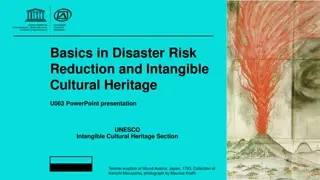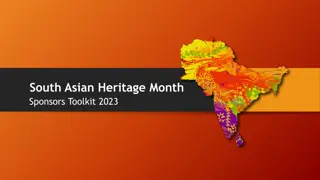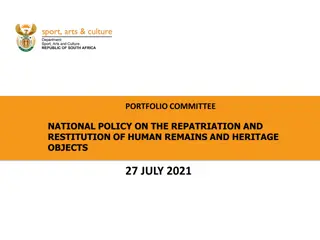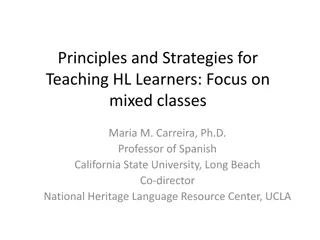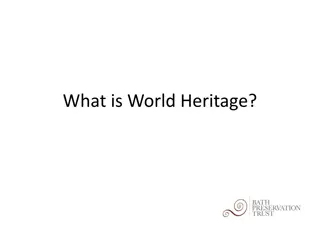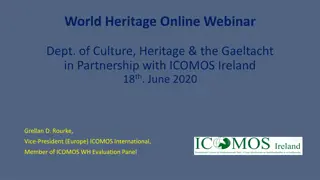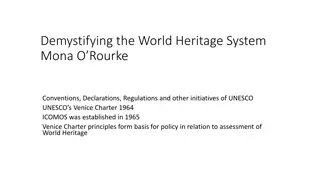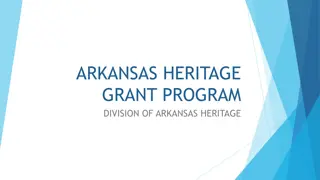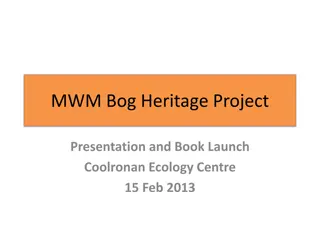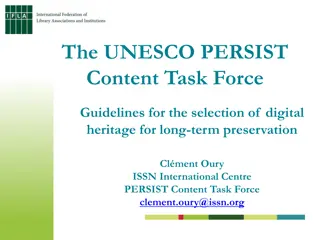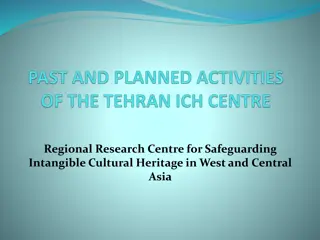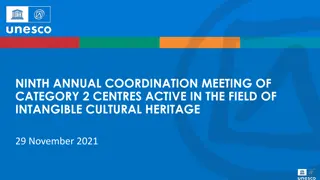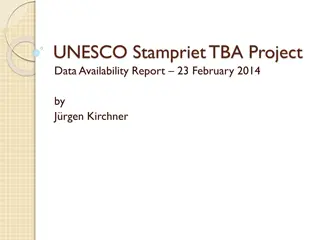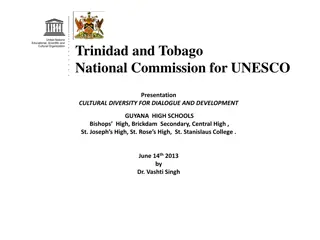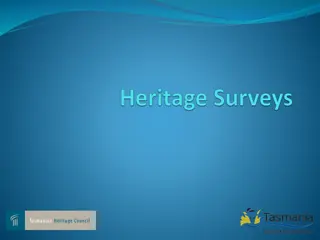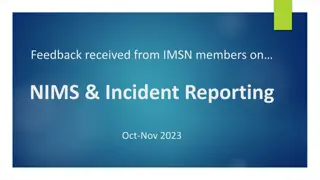UNESCO Living Heritage Reporting Framework Overview
In this presentation, the focus is on the periodic reporting unit of UNESCO's Living Heritage entity, detailing the obligations and purposes of periodic reporting under the 2003 Convention. The overall results framework (ORF) emphasizes safeguarding intangible cultural heritage for sustainable development, with clear pathways for engagement, recognition, and capacity-building. The 8 themes and 26 indicators of the ORF highlight community engagement, policy measures, education, and international collaboration for safeguarding cultural heritage effectively.
Download Presentation

Please find below an Image/Link to download the presentation.
The content on the website is provided AS IS for your information and personal use only. It may not be sold, licensed, or shared on other websites without obtaining consent from the author.If you encounter any issues during the download, it is possible that the publisher has removed the file from their server.
You are allowed to download the files provided on this website for personal or commercial use, subject to the condition that they are used lawfully. All files are the property of their respective owners.
The content on the website is provided AS IS for your information and personal use only. It may not be sold, licensed, or shared on other websites without obtaining consent from the author.
E N D
Presentation Transcript
Introducing periodic reporting Unit 57 PowerPoint presentation UNESCO UNESCO Living Heritage Entity
Reporting under the 2003 Convention A strict obligation to submit reports according to the form and periodicity set by the Committee (Article 29) Reports submitted according to Operational Directives 151-166 prepared by the Committee(Article 7(e)) 2
Purposes of periodic reporting Monitor the effective operationalization of the Convention at national level Take stock regularly of progress achieved and challenges encountered in implemeting the Convention Useful policy-making tool for countries Not an ends in itself, but part of the process of monitoring the results 3
Overall results framework (ORF) Intangible cultural heritage is safeguarded by communities, groups and individuals who exercise active and ongoing stewardship over it, thereby contributing to sustainable development for human well-being, dignity and creativity in peaceful and inclusive societies. Impacts Engagement and international cooperation for safeguarding enhanced among all stakeholders at all levels. Recognition and awareness of the importance of intangible cultural heritage and its safeguarding ensured. Continued practice and transmission of intangible cultural heritage ensured. Diversity of intangible cultural heritage respected. Long- term Outcomes Effective relationships built among a diversity of communities, groups and individuals and other stakeholders for safeguarding intangible cultural heritage. Dynamic development and implementation of safeguarding measures or plans for specific elements of intangible cultural heritage led by a diversity of communities, groups and individuals. Improved capacities to support the safeguarding of intangible cultural heritage in general. Improved capacities to implement safeguarding measures or plans for specific elements of intangible cultural heritage. Mid-term Outcomes Short- term Outcomes 4
The 8 themes and 26 indicators of the ORF Engagement of communities, groups and individuals as well as other stakeholders Role of intangible cultural heritage and its safeguarding in society Policies as well as legal and administrative measures Thematic Areas Institutional and human capacities Transmission and education Inventorying and research International engagement Awareness raising 1.Competent bodies support practice and transmission 2.Programmes support strengthening human capacities for safeguarding 3.Training is operated by or addressed to communities and those working in the fields of culture and heritage 4.Education, both formal and non- formal, strengthens transmission and promotes respect 5.ICH integrated into primary and secondary education 6.Post-secondary education supports safeguarding and study of ICH 7.Inventories reflect the diversity of ICH and contribute to its safeguarding 8.Inventorying process is inclusive, respects diversity, and supports safeguarding by communities and groups 9.Research and documentation contribute to safeguarding 10.Research findings are accessible and utilized 11.Cultural policies and legal and administrative measures reflect diversity of ICH and are implemented 12.Education policies and legal and administrative measures reflect diversity of ICH and are implemented 13.Policies and legal and administrative measures in fields other than culture and education reflect diversity of ICH and are implemented 14.Policies and legal and administrative measures respect customary rights, practices and expressions 15.Importance of ICH in society widely recognized 16.Inclusive plans and programmes recognize the importance of safeguarding ICH and foster self- respect and mutual respect 17.Communities, groups and individuals participate widely in awareness raising 18.Media are involved in awareness raising 19.Public information measures raise awareness 20.Ethical principles respected when raising awareness 21.Engagement for safeguarding ICH enhanced among stakeholders 22.Civil society contributes to monitoring safeguarding 23.Committee involves NGOs, public and private bodies, private persons 24.States Parties cooperate for safeguarding 25.States Parties engage in international networking and institutional cooperation 26.ICH Fund supports safeguarding and international engagement Core Indicators (brief) 5
Reporting on the implementation of the Convention See Operational Directives 153-158 Relevant to the design of the periodic reporting form ICH-10 6
Regional cycle of national reporting States Parties should submit their periodic reports to the Committee every six years on a regional rotation basis, as set by the Committee (OD 152). States Parties use the process: to enhance monitoring measures for active regional exchange and cooperation for efficient safeguarding of ICH 7
Regional overview of reports The Secretariat provides the Committee with an overview of all reports received in compliance with paragraph 152 four weeks prior to its session (OD 166). The overview is also made available online for public consultation, along with the reports received (in the original language), unless the Committee decides otherwise in exceptional cases (OD 166). 8
Aims of the periodic reporting process (1) Provide a mechanism to monitor effective implementation. Focus on outputs, outcomes and impact: results-based reporting aligned with the overall results framework for the Convention and its 26 indicators Provide a user-friendly and clear reporting framework Avoid unnecessary detail in reporting, while allowing for examples of good practices. 9
Aims of the periodic reporting process (2) Provide a useful tool for evaluating specific implementing measures and approaches and identifying good practices Provide a useful basis for States Parties to develop their own national monitoring systems. Create benchmarks against which progress (or regress) can be measured in future reporting. Aligned with the overall results framework for the Convention 10
Role of national focal points Responsible for completing the reporting exercise and filling the ICH-Form 10 Act as bridge between UNESCO, the Convention and national-level stakeholders Support is available through UNESCO capacity- building programme and training materials, inlcuding guidance notes 11
Overview of the Guidance Notes 1) Overview and rationale Indicator Assessment factors Relation with SDGs and other indicators Rationale for action Key terms 2) Specific guidance on monitoring and periodic reporting Benefits of monitoring Data sources and collection Extent to which indicator is satisfied 12
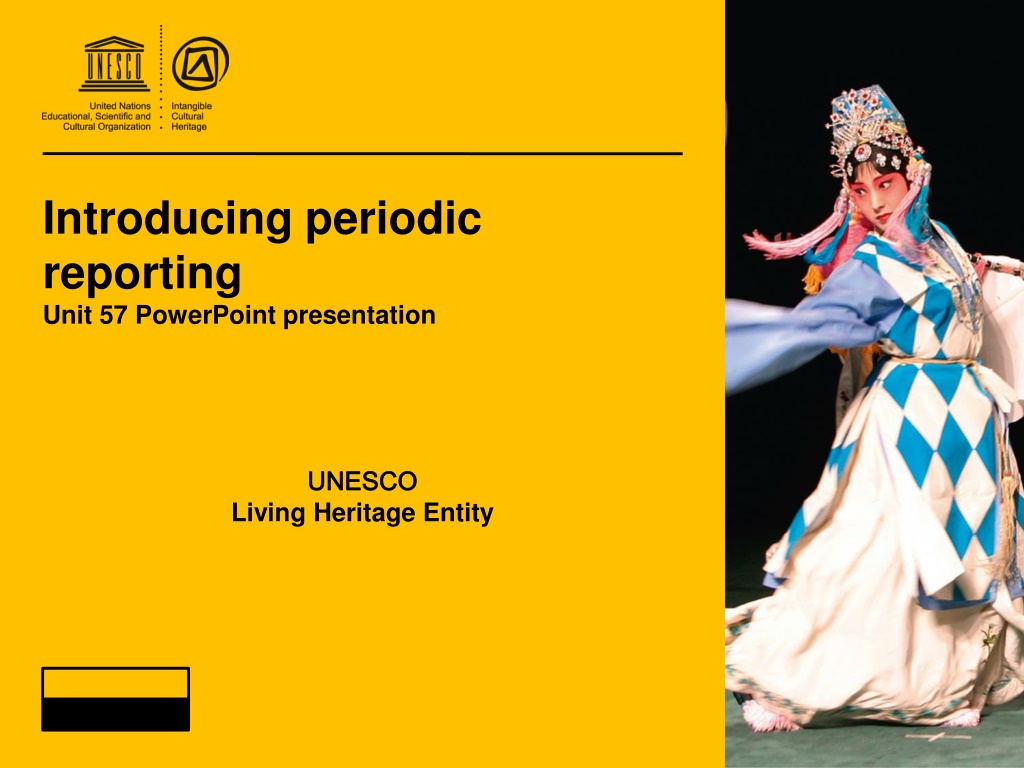
 undefined
undefined



















